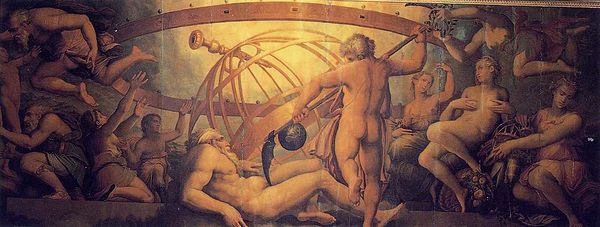أنو (إله)
| آنو Anu | |
|---|---|
أبو السماء، ملك الآلهة، رب الكوكبات | |
 | |
| المسكن | القطب الشمالي، دراكو |
| الجيش | النجوم والآلهة |
| الرمز | 𒀭 دينگير |
| معلومات شخصية | |
| الأبوان | أبزو ونـَمـّو (السومرية) أنشر وكيشار (السامية الشرقية) |
| القرين | أوراش (السومرية المبكرة), كي (السومرية المتأخرة)، آنتو (السامية الشرقية) |
| الأنجال | إنليل، إنكي، نيكيكورگا، نيدابا، بابا، في بعض النسخ: إنانا |
| الآلهة المكافئة | |
| المكافئ اليوناني | أورانوس وزيوس[1][2] |
آنو[أ] أو أن[ب] هو إله السماء عند سكان بلاد الرافدين، يقع ترتيبه من حيث الأهمية في قمة الآلهة السومرية الرئيسية. كان اسمه يُكتب بالعلامة المسمارية المسماة دينگير، وهي شبيهة بصورة النجمة الثمانية، إشارة إلى جميع جهات الكون الجغرافية، وهذا يعني أن الؤروس الثمانية تعبر عن الشمول، وتهدف أيضاً إلى التأكيد بان الإله موجود في كل مكان من الكون. كان مركز عبادة الإله أنو في مدينة أوروك (الوركاء)، في معبد يعرف بالمعبد الأبيض (نسبة إلى طلاء الجص الأبيض على جدرانه). كان متزوجاً من كي، ولكن في بعض ديانات بلاد الرافدين الأخرى كان له زوجة تسمى أوراس. على الرغم من أنه كان يعتبر الإله الأكثر أهمية في الپانثيون (مجمع الآلهة)، تولى دوراً في معظمه سلبي في الأساطير، سامحاً لإنليل بالمطالبة بالمنصب كالأله الأقوى. وابنته المفوضلة هي عشتار (أنانا)، وعبد الأب والبنت معاً في المركز الرئيسي لعبادتهما في مدينة الوركاء ويسمى تعبدهما (أي-أنا)، أي بيت السماء وصيغ من اسم أنو إلهة زوجة له أيضاً هي أنتم. ويبدو أن المنزلة الرفيعة التي كانت يحتلها الإله أنو باعتباره أباً للآلهة وملكها قد جعلته في منأى بعيد عن مشاكل الآلهة والبشر.[5]
. . . . . . . . . . . . . . . . . . . . . . . . . . . . . . . . . . . . . . . . . . . . . . . . . . . . . . . . . . . . . . . . . . . . . . . . . . . . . . . . . . . . . . . . . . . . . . . . . . . . . . . . . . . . . . . . . . . . . . . . . . . . . . . . . . . . . . . . . . . . . . . . . . . . . . . . . . . . . . . . . . . . . . . .
عبادته

العائلة
الأساطير
السومرية
أسطورة الخلق السومرية
الأكادية

الحيثية
التأثير اللاحق

انظر أيضاً
الهوامش
المصادر
المراجع
- Vv.Aa. (1951), University of California Publications in Semitic Philology, 11–12, University of California Press, OCLC 977787419
- Black, Jeremy; Green, Anthony (1992), Gods, Demons and Symbols of Ancient Mesopotamia: An Illustrated Dictionary, The British Museum Press, ISBN 0-7141-1705-6
- Burkert, Walter (2005), "Chapter Twenty: Near Eastern Connections", in Foley, John Miles, A Companion to Ancient Epic, New York City, New York and London, England: Blackwell Publishing, ISBN 978-1-4051-0524-8, https://books.google.com/books?id=V4mZmoZhG68C&printsec=frontcover&dq=Epic+of+Gilgamesh+Iliad+and+Odyssey&hl=en&sa=X&ved=0ahUKEwin1suR_PbaAhUtc98KHZgwCXUQ6AEIUTAI#v=onepage&q=Epic%20of%20Gilgamesh%20Iliad%20and%20Odyssey&f=false
- Coleman, J. A.; Davidson, George (2015), The Dictionary of Mythology: An A-Z of Themes, Legends, and Heroes, London, England: Arcturus Publishing Limited, ISBN 978-1-78404-478-7
- Clay, Albert Tobias (2006), The Origin of Biblical Traditions: Hebrew Legends in Babylonia and Israel, Eugene, Oregon: Wipf & Stock Publishers, ISBN 978-1-59752-718-7, https://books.google.com/?id=JKBLAwAAQBAJ&pg=PA101&dq=Anu+Ilu#v=onepage&q=Anu%20Ilu&f=false
- Dalley, Stephanie (1989), Myths from Mesopotamia: Creation, the Flood, Gilgamesh, and Others, Oxford, England: Oxford University Press, ISBN 0-19-283589-0, https://books.google.com/?id=7ERp_y_w1nIC&printsec=frontcover&dq=Ishtar+in+the+Epic+of+Gilgamesh#v=snippet&q=Ishtar&f=false
- Halloran, John A. (2006), Sumerian Lexicon: Version 3.0, http://sumerian.org/sumerlex.htm
- Harris, Rivkah (February 1991), "Inanna-Ishtar as Paradox and a Coincidence of Opposites", History of Religions 30 (3): 261–278, doi:
- Horry, Ruth (2016), Enki/Ea (god), Open Richly Annotated Cuneiform Corpus, UK Higher Education Academy, http://oracc.iaas.upenn.edu/amgg/listofdeities/enki/
- James, Edwin Oliver (1963), The Worship of the Sky-god: A Comparative Study in Semitic and Indo-European Religion, Athlone Press, OCLC 236664, https://books.google.com/?id=-1nXAAAAMAAJ
- Jordan, Michael (1993), Encyclopedia of Gods: Over 2,500 Deities of the World, New York: Facts on File, Inc., ISBN 978-0-8160-2909-9
- Karahashi, Fumi (April 2004), "Fighting the Mountain: Some Observations on the Sumerian Myths of Inanna and Ninurta", Journal of Near Eastern Studies 63 (2): 111–118
- Katz, D. (2003), The Image of the Underworld in Sumerian Sources, Bethesda, Maryland: CDL Press, ISBN 978-1-883053-77-2
- Kramer, Samuel Noah (1961), Sumerian Mythology: A Study of Spiritual and Literary Achievement in the Third Millennium B.C.: Revised Edition, Philadelphia, Pennsylvania: University of Pennsylvania Press, ISBN 0-8122-1047-6, http://www.sacred-texts.com/ane/sum/
- Kramer, Samuel Noah (1963), The Sumerians: Their History, Culture, and Character, Chicago, Illinois: University of Chicago Press, ISBN 0-226-45238-7
- Leeming, David Adams; Page, Jack (1996), God: Myths of the Male Divine, Oxford, England: Oxford University Press, ISBN 978-0-19-511387-7, https://books.google.com/?id=FdXgvMV89S0C&pg=PA109&dq=Anu+means+sky#v=onepage&q=Anu%20means%20sky&f=false
- Leick, Gwendolyn (1998) [1991], A Dictionary of Ancient Near Eastern Mythology, New York City, New York: Routledge, ISBN 0-415-19811-9, https://books.google.com/?id=CeEZD-9L5ogC&pg=PA8&dq=Anunnaki#v=onepage&q=Anunnaki&f=false
- Levine, Etan (2000), "Air in Biblical Thought", Heaven and Earth, Law and Love: Studies in Biblical Thought, Herausgegeben von Otto Kaiser, Berlin, Germany and New York City, New York: Walter de Gruyter, ISBN 3-11-016952-5, https://books.google.com/?id=6Vsg7VLyxuwC&pg=PA4&dq=Anu+means+sky#v=onepage&q=Anu%20means%20sky&f=false
- Liverani, Mario (2004), Myth and Politics in Ancient Near Eastern Historiography, Ithaca, New York: Cornell University Press, ISBN 978-0-8014-7358-6, https://books.google.com/?id=57CEOK0R4IMC&pg=PA21&dq=Adapa+myth#v=onepage&q=Adapa%20myth&f=false
- Mark, Joshua (20 January 2017), Anu, Ancient History Encyclopedia, https://www.ancient.eu/Anu/
- McCall, Henrietta (1990), Mesopotamian Myths, The Legendary Past, Austin, Texas: University of Texas Press, ISBN 0-292-75130-3, https://books.google.com/?id=pjyCCwZg5LAC&pg=PA65&dq=Anu+myths#v=onepage&q=Anu%20myths&f=false
- Mondi, Robert (1990), "Greek and Near Eastern Mythology: Greek Mythic Thought in the Light of the Near East", in Edmunds, Lowell, Approaches to Greek Myth, Baltimore, Maryland: The Johns Hopkins University Press, ISBN 0-8018-3864-9, https://books.google.com/?id=Vl_zWHnSkJAC&pg=PA170&dq=Anu+myth#v=onepage&q=Anu%20myth&f=false
- Nemet-Nejat, Karen Rhea (1998), Daily Life in Ancient Mesopotamia, Daily Life, Greenwood, ISBN 978-0-313-29497-6
- Parpola, Simo (1993), "The Assyrian Tree of Life: Tracing the Origins of Jewish Monotheism and Greek Philosophy", Journal of Near Eastern Studies 52 (3): 161–208, http://www.atour.com/education/pdf/SimoParpola-TheAssyrianTreeOfLife.pdf
- Piveteau, Jean (1981), "Man Before History", in Dunan, Marcel; Bowle, John, The Larousse Encyclopedia of Ancient and Medieval History, New York City, New York: Excaliber Books, ISBN 0-89673-083-2
- Pope, Marvin H. (1955), El in the Ugaritic Texts, 2, Leiden, The Netherlands: E. J. Brill, ISSN 0083-5889, https://books.google.com/?id=ns4UAAAAIAAJ&pg=PA2&dq=Anu+Ilu#v=onepage&q=Anu%20Ilu&f=false
- Puhvel, Jaan (1987), Comparative Mythology, Baltimore, Maryland: Johns Hopkins University Press, ISBN 0-8018-3938-6
- Rogers, John H. (1998), "Origins of the Ancient Astronomical Constellations: I: The Mesopotamian Traditions", Journal of the British Astronomical Association (London, England: The British Astronomical Association) 108 (1): 9–28, Bibcode: 1998JBAA..108....9R
- Saggs, H. W. F. (1987), Everyday Life in Babylonia & Assyria, Dorset Press, ISBN 0-88029-127-3
- Schneider, Tammi J. (2011), An Introduction to Ancient Mesopotamian Religion, Grand Rapids, Michigan: William B. Eerdman's Publishing Company, ISBN 978-0-8028-2959-7, https://books.google.com/?id=2HfU9gv0fXYC&pg=PA58&lpg=PA58&dq=Iconography+of+Enlil#v=onepage&q=Iconography%20of%20Enlil&f=false
- Sanders, Seth L. (2017), From Adapa to Enoch: Scribal Culture and Religious Vision in Judea and Babylonia, Tübingen, Germany: Mohr Siebeck, ISBN 978-3-16-154456-9, https://books.google.com/?id=TGz93hSO5k0C&pg=PA38&dq=Adapa+myth#v=onepage&q=Adapa%20myth&f=false
- Stephens, Kathryn (2013), An/Anu (god): Mesopotamian sky-god, one of the supreme deities; known as An in Sumerian and Anu in Akkadian, Open Richly Annotated Cuneiform Corpus, UK Higher Education Academy, http://oracc.museum.upenn.edu/amgg/listofdeities/an/
- Stone, Adam (2016), Enlil/Ellil (god), Open Richly Annotated Cuneiform Corpus, UK Higher Education Academy, http://oracc.iaas.upenn.edu/amgg/listofdeities/enlil/
- Van Scott, Miriam (1998), The Encyclopedia of Hell: A Comprehensive Survey of the Underworld, New York City, New York: Thomas Dunne Books/St. Martin's Griffin, ISBN 0-312-18574-X, https://books.google.com/?id=N1EnBgAAQBAJ&pg=PA187&dq=the+Underworld+in+Hittite+mythology#v=onepage&q=the%20Underworld%20in%20Hittite%20mythology&f=false


